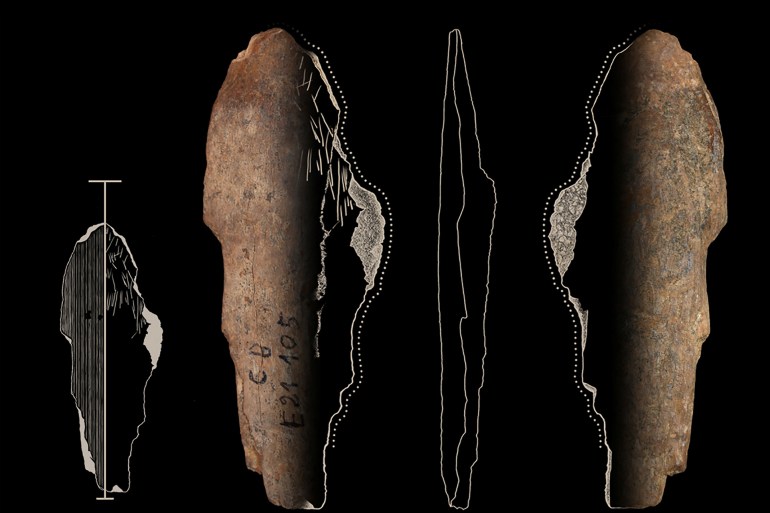Since ancient times, clothing has been a human necessity in addition to food and shelter, and its functions ranged from covering the body and protection from weather conditions, and extended to include cultural and psychological dimensions and indications of social status and even the fields of arts and economy, as clothing helped ancient humans to survive and thrive.
Although archaeologists lack a clear understanding of the origins of clothing, it is possible that our ancient ancestors wore clothing made from the skins of jackals, foxes and wild cats around 120,000 years ago.
This is what was revealed by researchers at the Max Planck Institute for the Science of Human History and Arizona State University in the United States, as they found bone groups that were used as tools for the manufacture of clothing from animal skins and fur in the “smugglers” cave near the Atlantic coast in Morocco, and estimated its history between 120 thousand and 90 thousand years. It went on to rank as the oldest evidence of the clothing industry to date, according to a study published by the journal iScience.
As the moral controversy revolves recently about fur clothing, it was in ancient times a necessity for survival, especially in the Pleistocene (ice) era, when large parts of the earth were covered with rivers and ice sheets more than 11,000 years ago, and researchers say that the ancient site - located in the city of Temara (south of the capital, Rabat) - dedicated to the production of leather and fur, and contains some of the oldest archaeological evidence of human clothing.
Interesting surprise
Researchers led by Emily Hallett of the Max Planck Institute for the Science of Human History in Germany first arrived at the cave to examine the bone fossils in order to determine what Pleistocene humans ate in the area, but what they found was more intriguing.
The clothes do not last for long periods, because they decompose and disappear in only a few hundred years, but the tools used to design them are more stable, and researchers - inside the Moroccan cave - discovered dozens of tools ideal for scraping animal skins to make leather and fur.
"Our findings show that early humans made bone tools for leather and fur, and this behavior is likely part of a larger tradition with earlier examples not yet found," Hallett says.
Ancient artifacts indicate that humans used bone tools to extract fur and leather to make clothes (Reuters)
“There are cracks on the flexible bone tools caused by use, and the shine on the tips of the bone tools is the result of repeated use against the skin. “Bone tools of this form are still used today to prepare leather because they do not penetrate the skin, they are durable and effective in removing connective tissue without damage to the skin.
In all, the scientists identified 62 different bone tools dating from 120,000 to 90,000 years ago, including a whale tooth that appears to have been used for peeling, and these tools were indeed specialized.
Researchers believe that our species began making clothes thousands of years before the history of Moroccan artifacts, although there is no archaeological evidence. Genetic studies of clothes lice by other researchers indicate that the origin of clothes may have been 170,000 years ago in Africa.
Besides the bone tools, scientists have found the remains of sand otters, golden jackals, and wild cats showing cut marks in patterns similar to those left by skinning.
Ancient cut marks around the animal's mouth show how humans in the Pleistocene era removed the skin of the head.
The marks left on the bones of these carnivores were not expected of animals slaughtered for eating, indicating that the hunters were only interested in obtaining the skins of those animals.
In the same cave, a marine mammal tooth (whale or dolphin) was also found in the cave, which may have been used as a peeling tool or used to sharpen the edge of another tool.
The artifacts in the cave date back to a time when evidence (in other parts of Africa) of jewelry, personal adornment and other signs of human symbolic expression appears at various archaeological sites.
The ancient climate controversy
But the climate around the cave of contribanders (smugglers) in Morocco was as relatively mild 100,000 years ago as it is today, and this has led some researchers - including Hallit - to suggest that clothing may not have been necessary for survival.
Ian Gilligan, author of Climate, Clothes, and Prehistoric Agriculture, comments that North Africa may have been surprisingly cold at times even in warmer times, so cold conditions and hypothermia would have been a clear threat to life.
Gilligan, an archaeologist at the University of Sydney who was not involved in the study, adds to Smithsonianmag;
Humans probably wore clothes even when conditions weren't harsh.
"This new study really provides the first good archaeological evidence for when clothing was made, and it reasonably coincides with the start of the last Ice Age about 120,000 years ago, so I think that's really important," Gilligan continues. The first clothing to protect against the cold in the context of icy cycles.
The onset of a colder climate is not the only interesting development that corresponds to the clothing industry in Africa. It was in that time period that personal ornaments appeared in human life in the Pleistocene era.
Evidence suggests that North African cave dwellers were making and wearing clothing long before the great ancient human migrations, and when these ancient peoples left Africa to populate the globe, it seems likely that they did so wearing animal skins.

